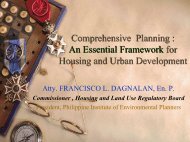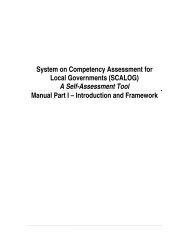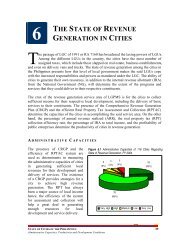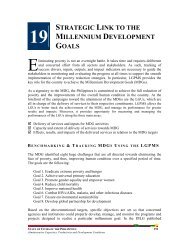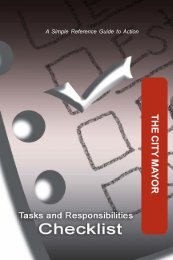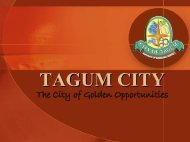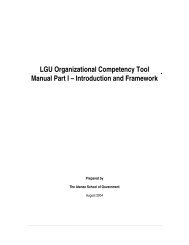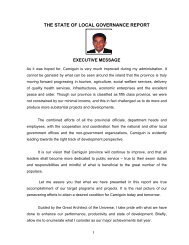100 Days City Mayors Revised - LGRC DILG 10
100 Days City Mayors Revised - LGRC DILG 10
100 Days City Mayors Revised - LGRC DILG 10
Create successful ePaper yourself
Turn your PDF publications into a flip-book with our unique Google optimized e-Paper software.
Critical Steps forthe first <strong><strong>10</strong>0</strong> daysA Guide for <strong>City</strong> <strong>Mayors</strong>20073
Critical Steps for the First <strong><strong>10</strong>0</strong> <strong>Days</strong>A Guide for <strong>City</strong> <strong>Mayors</strong>Critical Steps for the First <strong><strong>10</strong>0</strong> <strong>Days</strong> : A Guide for <strong>City</strong> <strong>Mayors</strong>Copyright © 2007 Local Government Academy (LGA)All rights reserved. No portion of this book maybe copied or reproduced inbooks, pamphlets, typewritten, xeroxed, or in any other form for distribution orsale, without permission from the Academy.ISBN No. : 978-971-0383-40-5Printed and bound in Manila, Philippines.Published by:Local Government Academy,Department of the Interior and Local Government8/F Agustin I Building, F. Ortigas Jr. Road, (formerly Emerald Avenue),Ortigas Center, Pasig <strong>City</strong>, 1605 PhilippinesTel. No. (632) – 634-8430 / 634-8436www.lga.gov.phThis project was undertaken in collaboration with the PhilippinesDevelopment Forum with financial support of the Government of Canadaprovided through Canadian International Development Agency (CIDA).4
CONTENTSMessagesSecretary . . . . . . . . . . . . . . . . . . . . . . . . . . . . . . . . . . . . . . . . . . . . . . 7LGA Executive Director . . . . . . . . . . . . . . . . . . . . . . . . . . . . . . . . . 8Philippines Development Forum . . . . . . . . . . . . . . . . . . . . . . . . . 9. League . of Cities of the Philippines . . . . . . . . . . . . . . . . . . . . . . . <strong>10</strong>Getting Started : Know the limitations and scope of your job as<strong>City</strong> Mayor . . . . . . . . . . . . . . . . . . . . . . . . . . . . . . . . . . . . . . . . . . . . . . . . . . . . . 11Form a Transition Team . . . . . . . . . . . . . . . . . . . . . . . . . . . . . . . . . . . . . . . . . 14Organize and staff the <strong>City</strong> Mayor’s office first and the offices of the<strong>City</strong> Administrator and Legal Officer. . . . . . . . . . . . . . . . . . . . . . . . . . . . . . . 16Make an intial analysis of the city government’s taffing pattern . . . . . . . 18Determine the fiscal status of your LGU . . . . . . . . . . . . . . . . . . . . . . . . . . . 20Determine the status of the Budget Call . . . . . . . . . . . . . . . . . . . . . . . . . . . 22Identify source of support and resistance . . . . . . . . . . . . . . . . . . . . . . . . . . 23Call for cooperation within the local bureaucracy . . . . . . . . . . . . . . . . . . . 25Commence interface with the local council . . . . . . . . . . . . . . . . . . . . . . . . 27Strengthen linkage with the barangays . . . . . . . . . . . . . . . . . . . . . . . . . . . . 29Re-organize the Local Special Bodies . . . . . . . . . . . . . . . . . . . . . . . . . . . . 31Review progress of the 2007 Annual Investment ProgramImplementation . . . . . . . . . . . . . . . . . . . . . . . . . . . . . . . . . . . . . . . . . . . . . . . . 35Implement doable commitments . . . . . . . . . . . . . . . . . . . . . . . . . . . . . . . . . 36Finalize preparation of the Executive Budget for 2008. . . . . . . . . . . . . . . . 38Document, disseminate and celebrate small wins. . . . . . . . . . . . . . . . . . 405
Critical Steps for the First <strong><strong>10</strong>0</strong> <strong>Days</strong>A Guide for <strong>City</strong> <strong>Mayors</strong>MESSAGE OF THE LEAGUEOn behalf of the League of Cities of the Philippines, I congratulate theLocal Government Academy for putting up this sourcebook on CriticalSteps for the First <strong><strong>10</strong>0</strong> <strong>Days</strong>: A Guide for <strong>City</strong> <strong>Mayors</strong>.Indeed, newly-elected <strong>City</strong> <strong>Mayors</strong> – especially those who are reallyserving as such for the first time – deserve to be guided right from thevery start of their incumbency. As we all know, the best way for a <strong>City</strong>Mayor to govern is to first learn the rudiments of the Office and all theunderpinnings that go with them. This Sourcebook responds to thisrequirement.At the same time, the book is also welcome material for veteran andreturning city mayors as it serves as a refresher guidebook in all aspectsof city administration.It is in this light that I, therefore, invite our fellow city mayors to porethrough the pages of this sourcebook, which is actually governance attheir fingertips.This Guide is our corridor towards learning and revisiting the basics ofcity governance and eventually our gateway to genuine development forour cities.Hon. JERRY P. TREÑASMayor, Iloilo <strong>City</strong>LCP National President<strong>10</strong>
1GETTINGSTARTED : KNOW THE LIMITATIONSAND SCOPE OF YOUR JOB AS CITY MAYORTo equip you with the necessary knowledgeneeded in performing your job as the topofficial of the city, you must know by heart thescope and limitations of your job. Your officialactions/decisions should always beknowledge-based.Action TakenThough you must have notions of what yourjob is or what it entails prior to your electioninto office, it would help a lot if you would:1. Read the Local Government Code of1991, the bible of local governmentofficials. For a start, you may readSection 455, Article One, Chapter 3,Book III of this Code. This specificpart of the Code provides your dutiesand responsibilities or your rolesand functions as a local chiefexecutive. Moreover, you may readthe powers and duties of theAdministrator (Section 480) and theLegal Officer (Section 481) to giveyou an idea of whom to appoint andwhat to expect from them.2. Read <strong>DILG</strong> memorandum circularsand other issuances of nationalgovernment agencies like the DOF,11
Critical Steps for the First <strong><strong>10</strong>0</strong> <strong>Days</strong>A Guide for <strong>City</strong> <strong>Mayors</strong>DBM, NEDA and presidential directives relevant to your tasks andresponsibilities. Request your city local government operationsofficer (CLGOO) to brief you on this.3. Know the limitations of your power and authority as a mayor. Ifyou understood your powers and functions as set out in theCode (see no. 1 above), you will also understand yourlimitations. For instance, while you have the power to appointofficials and employees paid out of city funds, this appointmentpower is not absolute in the sense that you must exercise thispower within the bounds of law (i.e., observing civil service rulesand regulations, Local Government Code). You cannot appointjust anybody to a position that requires certain qualifications(e.g., you cannot appoint a person to the position of cityaccountant if that person is not a certified public accountant).Also, understand that you have no power to appoint staff of theSangguniang Panlungsod because that power resides in the cityvice-mayor).4. Distinguish between official and ceremonial roles. (e.g.,documents for signing, social engagements, appointment ofpersonnel, etc.). Time management is the key to a smoothtransition so you must endeavor to prioritize your activities whiletrying to settle in. Social engagements like serving as sponsorto weddings and baptisms could be a low priority activity or youcould ask a proxy to stand in for you.12
5. Attend short courses on localgovernance. There are universitiesand training institutions offeringcourses on local governance. Youcan ask your staff to inquire aboutthese offerings, or you can inquirefrom the Local Government Academyof the <strong>DILG</strong> or the Center for Localand Regional Governance of theUniversity of the Philippinesregarding their course offerings. Ifyou cannot go out of town to attendthese courses, you may considerhiring a special tutor who can teachyou at your convenient time andplace.Action TakenMost, if not all of these suggested activitiescould be done even prior to your inauguration.13
Critical Steps for the First <strong><strong>10</strong>0</strong> <strong>Days</strong>A Guide for <strong>City</strong> <strong>Mayors</strong>2FORMA TRANSITION TEAM!Given our human limitations, we cannot do everything on our own. Atransition team is needed to assist you in your entry to your new “world” ororganization. This team serves as your “arms and legs”, “ears and eyes”while you are settling in as a new city mayor.In forming your team, you may do the following:1. Ideally, as courtesy, request the outgoing LCE to recommendstaff from the local bureaucracy as members of the transitionteam.2. If not possible, ensure that the Local Finance Committee(including the Accountant), outgoing Administrator/incomingAdministrator and HRMO to form part of the transition team. TheLFC will serve as your advisor on matters pertaining to localgovernment finance.3. Aside from your campaign/core staff, you may also inviterepresentatives from the academe, civil society, and businesssectors, only if you think their inputs are valuable to theformulation of your administration agenda.Ideally, initial planning, strategizing and organizing should happen rightafter your proclamation as the winner. In this case, this could be done inmid-May.14
The possible tasks and functions of yourtransition team are the following:• Assist the LCE in formulating ashort-term administration agendathat is good for the first <strong><strong>10</strong>0</strong> days.The agenda may include yourelection promises, which can berealistically delivered in your first <strong><strong>10</strong>0</strong>days.• Coordinate with the key staff of thecity government on all cityadministration matters.• Assist the LCE in financial review• Assist the LCE in preparingfor the inaugural ceremony• Run a personnel inventory• Recommend actions onstaffing• Select nominees (core staffand/or experts) for coterminuspositions (only whenyou need their advice on thematter)Action Taken15
Critical Steps for the First <strong><strong>10</strong>0</strong> <strong>Days</strong>A Guide for <strong>City</strong> <strong>Mayors</strong>3ORGANIZETHE STAFF OF THE CITY MAYOR’SOFFICE FIRST AND THE OFFICES OF THE CITYADMINISTRATOR AND LEGAL OFFICERThe Mayor’s Office is the hub of the city government; hence it should beset up as soon as you assume office. The Administrator is your chiefexecutive officer or your alter ego even, and the Legal Officer is the chieflegal counsel of the <strong>City</strong> Government. Their services are urgently needed,thus their offices should be set up immediately along with the Mayor’sOffice.In organizing and staffing, the following are suggested activities:1. Review the plantilla positions in your office to check the numberof confidential/personal staff you can appoint. (This could actuallybe done even prior to July 1). If the plantilla has five positionsavailable, you may start with less than five and then assess laterif there is a need to fill up the remaining vacancy/cies.The Administrator and Legal Officer are two mandatory, butco-terminous, positions that you should fill up. From the list ofnominees (if any) choose the ones you want to appoint. Makesure though that they meet the minimum qualificationsprescribed by the Local Government Code. In case you want toretain the services of the Administrator and or Legal Officer of theprevious mayor, you must have your reasons to do so.Otherwise, ask them to tender their voluntary resignation so youcan fill up their positions.2. Check as well the qualifications of the personal staff you want toappoint to determine if they have the capability to perform theirexpected functions and tasks effectively and efficiently. Aside fromtheir loyalty as a criterion in choosing them, make sure they havethe potential to function with minimum supervision.16
3. If they qualify, talk to your appointees and get their commitment.4. Briefly describe/explain their core functions as well as theirremunerations, benefits and other entitlements or ask the HRMOto do this.5. Ask the HRMO to prepare theirappointment papers and havethem processed.Action Taken6. Assess the physical appearanceand layout of your office.Determine if you want to do someimprovements or changes thatwould suit your working style. If youdecide to make improvements inyour office, consider also thecomfort of your daily visitors.7. Check also the status of theequipment and furniture of youroffice. Determine if they need tobe repaired or replaced. Ask yourGSO to attend to this matter. (Thisactivity together with activity 6 couldbe done simultaneously with theorganization and staffing of theabove-mentioned offices).Your possible appointees are theAdministrator, Legal Officer, Head ExecutiveAssistant/Chief of Staff, Executive Assistant/s, Secretary to the LCE, and security force orpersonal bodyguards17
Critical Steps for the First <strong><strong>10</strong>0</strong> <strong>Days</strong>A Guide for <strong>City</strong> <strong>Mayors</strong>4MAKEAN INITIAL ANALYSIS OF THE CITYGOVERNMENT’S STAFFING PATTERN!An analysis of the staffing pattern of the city government will give you anidea of whether the local bureaucracy is overstaffed or understaffed in acertain office or offices. This will also guide your decision to hire or firecontractual and casual workers.1. Request the HRMO to submit (a) a personnel inventory, (b)performance evaluation reports of casuals and contractuals, and(c) the organization and staffing charts of each department oroffice in the city government. Based on these documents:• Determine the number of casuals and contractuals peroffice or per project• Determine the number of regular staff who are detailed toother offices• Look at the work history of the casuals: are there casualswho have been with the <strong>City</strong> Government for so many years?• Determine what offices appear to be understaffed oroverstaffed.2. Assess the need to renew or not to renew contractual/casualworkers based on your findings, and make a short list of thoseyou may want to renew and those you will no longer renew.3. Make a plan on what to do with the problem of overstaffing orunderstaffing in your organization. As an interim measure, youmay or may not recall the personnel detailed to their motherunits or offices. (For an in-depth evaluation of your organization,you may want an external consultant to do an organization andmanagement study of your city government after your first <strong><strong>10</strong>0</strong>18
days. The results of this planned study will guide you in decidingto implement reorganization or not.)4. Discuss your planned measures with the transition team anddepartment heads concerned (those whose offices areoverstaffed or understaffed) and decide the right time for carryingout your plan.5. Be mindful of your limitationconcerning appointments (seesteps 1 no. 3), hence, you knowwhat to do when jobapplications swamp your office.Action Taken19
Critical Steps for the First <strong><strong>10</strong>0</strong> <strong>Days</strong>A Guide for <strong>City</strong> <strong>Mayors</strong>5DETERMINETHE FISCAL STATUS OFYOUR LGU!The fiscal status of the city government is the indicator of its financialhealth. The level of the city’s financial resources serves as your guide inyour allocation and spending decisions particularly within your first <strong><strong>10</strong>0</strong>days in office.1. On your first day in office ( 1 st working day of July) request thefollowing financial reports or documents:• From the Treasurer, a copy of Report of Collection forthe Period January-June. This report will give youinformation on how much have been collected for thefirst two quarters of the year. Further, it will show anyincrease or decrease in the collections during thisperiod.• Also from the Treasurer, a copy of Report of CashTransactions and Funds Available as of June 30 or thelast working day of June. This will reveal how much havebeen disbursed and how much money is available inthe treasury when you assumed office.• From the Budget Officer, a copy of the annual budget ofthe city including the Annual Investment Program and orsupplemental budget/s if any. The annual city budgetdocument also contains a statement of income andexpenditures made by the <strong>City</strong> Government.• From the Accountant, a copy of the Balance Sheet for thefirst two quarters of the year. The Balance Sheetcontains, among other things, a statement of assetsand liabilities of the <strong>City</strong> Government. Also, take note of20
the unliquidated cash advances and obligationsincurred by the previous administration.• From the GSO, a Property Inventory Report per office.This document contains information on the types andquantities and condition of city government properties.2. Meet with the Local FinanceCommittee. If the <strong>City</strong> Accountant isnot a member of this committee,include him/her in the meeting.Discuss with them your impressionsand concerns about the informationyou have gathered from the financialreports and documents. Askquestions on anything you do notunderstand about the financialreports and documents.Action Taken3. Set a regular schedule of meetingwith the LFC to discuss plans andmeasures for revenue mobilizationand utilization.4. To check the veracity of the propertyinventory report, you can assign atrusted staff to conduct physicalinventory of said properties.21
Critical Steps for the First <strong><strong>10</strong>0</strong> <strong>Days</strong>A Guide for <strong>City</strong> <strong>Mayors</strong>1.2.3.4.PersonAlly Fence-sitter OpponentDegree ofInfluence** VI (very influential), I (influential), NI (not influential), and U (unknown)4. Complete this matrix and/or validate your findings as you goalong the succeeding steps.5. Replicate this activity if you also desire to locate the positions ofthe local legislators, barangay heads, and civil societyorganizations. You or your team may already have first handknowledge of this based on your experience and observationsbefore or during the campaign period.6. Once you locate your allies and opponents, you are now ready tocall for cooperation and harmony.24
8CALLFOR COOPERATION WITHIN THELOCAL BUREAUCRACY!Once you have initially located the respectiveposition of your subordinates and partners indevelopment, you may now promoteteamwork and unity, particularly in the cityhall. The performance of the localbureaucrats under your administration willmirror your performance as a leader. Hence,to serve and satisfy your constituents, youmust ensure that the employees in yourorganization are able to translate theorganizational goals and the pledges youcommitted during your campaign. To get thecooperation of the whole workforce, thefollowing steps are proposed:Action Taken1. Visit each office or department incity hall. To get to know your staffbetter and to validate propertyinventory report, make time to atleast drop by each office. You can dothis with the help of your transitionteam, who will coordinate with thedepartment heads.2. Understand their situation. Befamiliar with their problems and besensitive to their needs. Consider25
Critical Steps for the First <strong><strong>10</strong>0</strong> <strong>Days</strong>A Guide for <strong>City</strong> <strong>Mayors</strong>their peculiarities (health condition, cultural or religiousbackground, sexual orientation, etc.), and respect differences.3. Mind your people. Get acquainted with their work processes andhave first hand knowledge of their working conditions. Ifnecessary, improve the occupational health and safety of eachdepartment by considering the ergonomic furniture, equipment,work guidelines and requirements, and the whole workstationenvironment. This is one approach of getting their utmostsupport, as well as inducing their full potential.4. Create momentum. Through a memorandum from your office orthrough the coordination of your transition team, ask eachdepartment head to quickly brief you and your team on theirperformance for the last two or three years, as well as to sharetheir issues, problems and their correspondingrecommendations for action.5. Build personal credibility. Present the thrusts and direction ofyour administration, and explain your leadership andmanagement style, including the performance checks, protocols,and communication links. If it is not too soon, try to reach aconsensus between your goals and theirs.26
9COMMENCEINTERFACE WITH THE LOCALCOUNCIL!While the executive and legislative branchesare both independent, you might also want topromote harmony between the two. The localcouncil is a source of power that can aid orhamper the realization of some of yourprograms. Hence, a strong professionalrelationship with the council is desirable.Action Taken1. Visit the legislative office or building.To get to know the legislative staffbetter and to validate propertyinventory report, pay them a visit.Understand their situation and attendto the needs of your employees (seeStep 8).2. Harmonize your platform with theexisting policies. Through your teamor through a memo of request to thelegislative office and all departments,you may also want to compile theimportant national laws, cityordinances and executive orders ofthe past administration. Familiarizeyourself with the pertinent policies,especially those that will heavilyinfluence your program of action.27
Critical Steps for the First <strong><strong>10</strong>0</strong> <strong>Days</strong>A Guide for <strong>City</strong> <strong>Mayors</strong>3. Be familiar with the legislative processes, particularly theapproval of ordinances (Section 54, 1991 Local GovernmentCode) and your veto power as city mayor (Section 55), as well asits enforcement and effectivity (Sections 58 and 59).4. Build harmonious relationship with the legislative branch. Askyour staff or your transition team to secure from the Office of the<strong>City</strong> vice-Mayor an invitation letter to invite you as special guestduring their first session. In this event, you may discuss thepossible formulation of an executive-legislative agenda (ELA).The ELA is an integrated plan that will harmonize the executiveand legislative actions towards the delivery of a common set ofdevelopment priorities for the city. It is an implementingmechanism for the Comprehensive Development Plan; henceELA encompasses the three-year Local Development InvestmentPlan, current Executive Budget and current Annual InvestmentPlan.28
<strong>10</strong>STRENGTHENLINKAGE WITH THEBARANGAYS!While the barangays are discrete localgovernment units, they are under yourjurisdiction. Section 32 of the LocalGovernment Code states that the <strong>City</strong> <strong>Mayors</strong>hall “exercise general supervision overcomponent barangays to ensure that saidbarangays act within the scope of theirprescribed powers and functions.” Thebarangay is the basic political unit, whereprimary planning and implementation ofpolicies are realized. Hence, for the whole<strong>City</strong> Government to act in unison, itscomponent units should have common orharmonized development goals and vision.Action Taken1. Visit your constituents in thebarangays. Ask your team tocoordinate with each barangay headfor an informal dialogue. This is alsoa timely opportunity to personallyexpress your gratitude for their voteand support during the campaign. Itis also an opportunity to encouragethem to initiate or sustaindevelopment efforts.2. Listen to their voices. Understandtheir situation and peculiar needs.Ask them to brief you on their29
Critical Steps for the First <strong><strong>10</strong>0</strong> <strong>Days</strong>A Guide for <strong>City</strong> <strong>Mayors</strong>issues, problems and the corresponding recommendations foraction.3. Create momentum. Win their support, if they are not yet activesupporters. Present the direction and development priorities ofyour administration. Ask them, particularly the rural barangays ofthe <strong>City</strong> if any, to become active partners in combating poverty.4. Build relationships. Create a better mechanism for <strong>City</strong>barangayinteraction, particularly the accessibility to your officeand the submission of proposals as a requirement for projectsto be included in the Annual Investment Plan.30
11RE-ORGANIZETHE LOCAL SPECIALBODIES!Section 34 of the 1991 Local GovernmentCode provides for the promotion of civilsociety organizations (CSOs), particularly thenon-government and people’s organizations(NGOs and POs) to become active partners oflocal autonomy and development. Theseorganizations form part of the civil society,which is a key partner in planning,implementing and monitoring projects.Action TakenThe civil society is democratically representedin local governance through the Local SpecialBodies (LSBs), which are generally tasked toformulate policy recommendations for theguidance of the Sanggunian. These are theLocal Development Council (LDC), Local Bidsand Awards Committee (BAC), Local SchoolBoard (LScB), Local Health Board (LHB),Local Peace and Order Council (POC) and thePeople’s Law Enforcement Board (PLEB).• The main planning and advisorycouncil that sets the direction ofeconomic and social developmentand coordinates development effortswithin the <strong>City</strong> by formulatingdevelopment plans, policies andpublic investment31
Critical Steps for the First <strong><strong>10</strong>0</strong> <strong>Days</strong>A Guide for <strong>City</strong> <strong>Mayors</strong>programs. You are the chair of this body. (See 1991 LocalGovernment Code for more details)• The local BAC is responsible for pre-procurement and prebiddingactivities, bidding and the evaluation of bids, andrecommendation of award of all local infrastructure-relatedcontracts. As head of the procuring entity, you approve the budgetfor the contract. (See Republic Act 9184 or E-procurement law formore details).• The LScB and LHB are advisory committees concerned withschool and health matters, respectively. The former determinesannual supplementary budgetary needs for operation andmaintenance of public schools in the <strong>City</strong>, while the latterproposes to the sanggunian annual budgetary allocations foroperation and maintenance of health facilities and services. Youare the chair of the LHB, and a co-chair of the LScB. (See 1991Local Government Code for more details).• The local POC formulates plans and recommends measures toimprove peace and order condition in the <strong>City</strong>. It also monitorspeace and order programs and projects, counter-insurgencyprograms, and activities of the civilian volunteer organizations.The PLEB is a body that you have no control, over direct orindirect. It hears and decides people’s complaints or cases filedbefore it against erring officers and members of the PhilippineNational Police. (See 1991 Local Government Code for moredetails).There is a checklist and processes that need to be verified and achieved,respectively, for you to be able to reconstitute and reconvene the LSBs.32
1. Be familiar with the functions, rolesand composition of LSBs, as well astheir capability requirements.2. Update information. Ask yourPlanning and DevelopmentCoordinator to provide you with aninventory of all CSOs in the <strong>City</strong>. Theinventory should include an updatedprofile of each organization, as wellas a directory and list of accreditedgroups.3. Create partnerships. Ask your teamto arrange a formal or informaldialogue with them. It is one way ofvalidating their existence and status,and the best avenue to inform themof the accreditation and selectionprocesses for inclusion in the LSBs.Action Takena.)b.)Maximize this opportunity topresent the thrusts anddirection of youradministration, and theirroles in achieving yourdevelopment priorities.Listen to their voices.Understand their situationand peculiar needs. Askthem to brief you on theirissues, problems and thecorrespondingrecommendations foraction.33
Critical Steps for the First <strong><strong>10</strong>0</strong> <strong>Days</strong>A Guide for <strong>City</strong> <strong>Mayors</strong>4. Be informed. Ask your team to keep you posted on theaccreditation processes and results, as the Sanggunian holdsthe exclusive jurisdiction of accrediting organizations for LSBs.Selection, on the other hand, is performed by and among theofficial representatives of the accredited groups.5. Immediately after the selection process, reconvene the LSBsthrough the issuance of an executive order.6. Convene the LSBs consistent with the guidelines of the 1991Local Government Code.34
12REVIEWPROGRESS OF THE 2007ANNUAL INVESTMENT PROGRAMIMPLEMENTATIONThis AIP was prepared by the previousadministration. A review is necessary to findout the status of projects and troubleshoot, ifnecessary.Action TakenThe following activities are suggested:1. Ask the <strong>City</strong> Planning andDevelopment Officer to give you anupdate on the status of the differentprograms and projects funded out ofthe 20% Development Plan. Forinfrastructure projects, ask theEngineer to apprise you on these.2. Request all project leaders orimplementers to submit a formalmonitoring and evaluation report onall projects under the AIP. This will aidyou in deciding what projects areworth continuing or terminating.3. Request your Legal Officer to review all project contracts(especially infrastructure projects) to determine that these aremade above board. If there are spurious contracts entered intoby the past administration, ask the Legal Officer to take remedialsteps. These spurious contracts may be renegotiated, amendedor even annulled.35
Critical Steps for the First <strong><strong>10</strong>0</strong> <strong>Days</strong>A Guide for <strong>City</strong> <strong>Mayors</strong>13IMPLEMENTDOABLE COMMITMENTS!An early victory, no matter how big or small, iskey to proving your worth as a leader. To makean immediate impact and gain the trust of thepeople, an attainment of at least one pledgemade during the campaign is an attractivestart. However, this endeavor must be viableas well as effective in creating momentumduring your first <strong><strong>10</strong>0</strong> days in office.Action Taken1. Keep track of your commitments. Askyour transition team to develop yourplatform during the campaign periodinto a full-blown action plan, one forthe next <strong><strong>10</strong>0</strong> (short-term) days andanother for the <strong><strong>10</strong>0</strong>0 (full-term) days.2. Mobilize your team. Build a taskforceor ad hoc committee to prioritizecommitments, which will be rankedaccording to viability, urgency andimpact.3. Identify sources of funding. Ask theLFC, particularly the Treasurer, if the<strong>City</strong> Government can finance yoursmall priority projects. If funds areavailable, supplement your budget36
through the local Sanggunian. You may also consideralternatives, such as mobilizing the whole community by invokingthe spirit of bayanihan, or requesting financial assistance fromyour Congressman or other donor agencies.4. Implement. Show commitment and sincerity by fulfilling yourpromises. Remember, your constituents will be judgmental andwill make an initial assessment of your administration based onthe fulfillment of the promises you made. Show them why you areworthy of their mandate.37
Critical Steps for the First <strong><strong>10</strong>0</strong> <strong>Days</strong>A Guide for <strong>City</strong> <strong>Mayors</strong>14FINALIZEPREPARATION OFEXECUTIVE BUDGET FOR 2008On or before 16 October, you are mandatedby law to submit your budget to theSangguniang Panglungsod for budgetauthorization.Action TakenThe following are the activities that you cando:1. Ask the Budget Officer to finishconsolidating the budget proposalsof offices and departments, and tosubmit the consolidated budget toyour office on or before 16September.2. Together with the LFC, review theconsolidated budget proposals todetermine whether this could besupported by funds budgeted orestimated for the period.3. Together with the Planning andDevelopment Officer, craft an AnnualInvestment Program for 2008. Bemindful of your campaign promisesand the proposed projects of thebarangays, as well as the programs/projects of the past administrationthat are worth continuing.38
4. Reiterate your development priorities to the LFC and thenrequest it to come up with expenditure and sectoral budgetceilings.5. With the advice of the LFC, decide where budget cuts/caps couldbe made in the consolidated budget proposal.6. Taking all inputs from the above activities, finalize the annualExecutive Budget for 2008. Be prepared to submit your budget tothe Sanggunian by 16 October at the latest.39
Critical Steps for the First <strong><strong>10</strong>0</strong> <strong>Days</strong>A Guide for <strong>City</strong> <strong>Mayors</strong>15DOCUMENT,DISSEMINATE ANDCELEBRATE SMALL WINS!As you are acting on behalf of the people,place a premium on communicating themessage. Always involve and inform thepeople. This way, you promote transparencyas well as indirectly elicit more support andtrust. Make a quick assessment of yourperformance and document accordingly forpopular dissemination. When all is said anddone in your first <strong><strong>10</strong>0</strong> days in office,celebrate and bask in the glory of yourcommitment and hard work.Action Taken1. Document. Create a team todocument the initial successes ofyour administration within the first<strong><strong>10</strong>0</strong> days. Make sure thesuccesses are cleverly anchored inyour promises. Spot the lapses andturn them into actionable agenda.2. Disseminate.a. The small wins will solidifythe momentum youcreated in yourbureaucracy. Make surethe civil servants, as wellas your partners in thebarangays, are wellinformedof your40
administration’s early successes. Recognize their trustand support.b. For maximum impact, use all possible media ofcommunication (print, radio, television, internet andface-to-face formal address) in communicatingsuccesses to the civil society organizations, the privatesector and the whole citizenry. This will help build yourpersonal credibility to the people, and will likely stirsupport and recognition from reluctant parties.c. Communicate your development agenda. This is also atimely opportunity to tell your constituents what they willexpect in the succeeding <strong><strong>10</strong>0</strong>0 days under youradministration.3. Celebrate. Take time to relish your victories, big or small. Youand your organization are now geared up for the remaining <strong><strong>10</strong>0</strong>0days in office. Sustain your efforts, fulfill all promises and deliverservices in an efficient and effective manner. Never lose focus.41
42Critical Steps for the First <strong><strong>10</strong>0</strong> <strong>Days</strong>A Guide for <strong>City</strong> <strong>Mayors</strong>
AcknowledgementWe would like to extend our appreciation to the working team thatmade the completion of this publication possible—from the UPNCPAG – Center for Local and Regional Governance for thecontents and insights, to the LGA personnel who gave time andtalent to see this piece of work to print.Likewise, we recognize the various institutions particularly the localgovernment leagues, the national government agencies, theacademe and non-governmental organizations for their generosityin sharing their recommendations and inputs so that the readingmaterial would be much more understandable and useful toordinary citizens.The list will not be complete if the development partners, specificallythe Philippines Development Forum Working Group onDecentralization and Local Government are not acknowledgedbecause they are the ones who principally gave impetus to thisendeavor.Without being specific, there are still others who worked to makethis publication possible. We sincerely thank them and we areconfident that they are one with us in advocating excellent localgovernance in the Philippines.43
44Critical Steps for the First <strong><strong>10</strong>0</strong> <strong>Days</strong>A Guide for <strong>City</strong> <strong>Mayors</strong>



